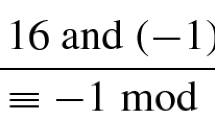Abstract
The Galois group of the maximal unramified p-extension (p 2) of an imaginary quadratic field is investigated for the case where the group is finite. It is shown that the group can be generated by not more than two generators with two relations. One of the relations can be taken from the 3rd term of the Zassenhaus filtration of the free group, and the second, from the 2nd, 5th, or 7th term.
Similar content being viewed by others
Literature cited
H. Koch, “Zum Satz von Golod-Schafarewitch,” Math. Nachr.,42, 321–333 (1969).
H. Koch, Galoissche Theorie der p-Erweiterungen, Berlin (1970).
M. Lazard, “Groupes analytiques p-adiques,” Publ. Math. IHES,26, 389–609 (1965).
J. Mennicke, “Einige endliche Gruppen mit drei Erzeugenden and drei Relationen,” Arch. Math.,10, 409–418 (1959).
I. V. Andozhskii and V. M. Tsvetkov, “On a series of finite closed p-groups,” Izv. Akad. Nauk SSSR, Ser. Mat.,38, No. 2, 278–290 (1974).
J.-P. Serre, Galois Cohomologies [Russian translation], Moscow (1968).
M. Hall, Theory of Groups, Macmillan (1961).
I. R. Shafarevich, “Extensions with specified branching points,” Publ. Math. IHES,18, 71–92 (1964).
Additional information
Translated from Zapiski Nauchnykh Seminarov Leningradskogo Otdeleniya Matematicheskogo Instituta im. V. A. Steklova AN SSSR, Vol. 46, pp. 5–13, 1974.
Rights and permissions
About this article
Cite this article
Venkov, B.B., Koch, H. The p-tower of class fields for an imaginary quadratic field. J Math Sci 9, 291–299 (1978). https://doi.org/10.1007/BF01085047
Issue Date:
DOI: https://doi.org/10.1007/BF01085047




